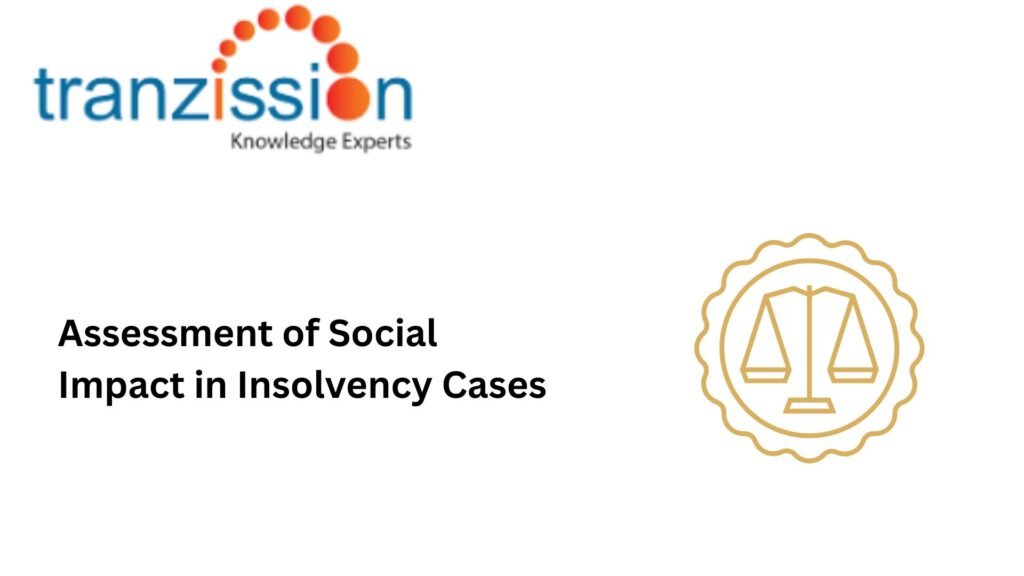
Assessment of Social Impact in Insolvency Cases

Table of Contents
Social Impact in Insolvency Cases is a process of evaluating and managing the social consequences of a company’s insolvency or bankruptcy. It helps understand the ripple effects on employees, families, communities, and other stakeholders. Thus, it ensures a more comprehensive approach to insolvency resolution. In insolvency cases, SIA helps to ensure that the resolution process is not only financially sound but also socially responsible, minimising harm and promoting a more equitable outcome for all stakeholders.
Economic Impacts
The key economic impacts of Social Impact in Insolvency Cases in insolvency cases are:
Job Losses and Employment Challenges:
Insolvency proceedings often lead to job losses and have a negative impact on local economies. When a company goes bankrupt, employees may be laid off, and the closure of the business can also affect related industries and individuals. This can lead to decreased consumer spending and reduced demand for goods and services, further impacting the local economy.
Decline in Asset Values:
Forced asset sales during insolvency lead to undervaluation, thus adversely impacting shareholders and investors. If creditors are not satisfied with the value they receive from asset sales, they may be less inclined to support a resolution plan, potentially leading to liquidation instead. Further, the undervaluation of assets affects market stability and reduces investor confidence.
Creditworthiness and Investment Climate:
High insolvency rates can discourage potential investors and make it difficult for businesses, particularly in sectors with frequent insolvencies, to access credit. This is because investors may perceive a higher risk of losing their investment, while lenders may be willing to provide loans to businesses perceived as being at higher risk of default.
Read more : What is Form G in IBC – Invitation for Expression of Interest
Social Impact in Insolvency Cases
Financial Hardship for Individuals:
Insolvency can lead to layoffs, significantly impacting the livelihoods of workers and their families. Unemployment can exacerbate existing social inequalities, increasing the vulnerability of certain groups.
Community and Societal Effects:
Supply chains can be disrupted by insolvency and can reduce the availability of goods and services, affecting local communities. This can potentially increase social unrest due to economic disparities.
Impact on Stakeholders
On Creditors: Delayed or reduced repayments can strain financial institutions and suppliers. For creditors, Social Impact in Insolvency Cases can highlight the potential for job losses, business closures, and a decline in the local economy, which could affect their ability to recover their debts.
On Debtors: The financial hardship faced by corporate debtors during insolvency, such as the decline in the value of their assets, can affect future business endeavors. They may also face a loss of business ownership, in which their personal liabilities may also increase.
Broader Economic Considerations
Multiple insolvencies can negatively impact the economic health of a country. A rise in insolvencies, particularly among larger businesses, can lead to higher non-performing loans in the banking sector, hindering their ability to lend and support economic recovery. Many insolvent firms can make it difficult for the financial system to allocate resources to the most productive businesses efficiently. This can lead to wasted resources and slower economic growth. Therefore, insolvencies can have cascading effects throughout the economy and negatively impact national credit ratings and international trade relations.
Conclusion
By addressing economic and social impacts proactively, SIA can contribute to more successful and sustainable insolvency resolution. While the insolvency framework in India provides a structured approach to insolvency, it is also essential to address its economic and social ramifications. To mitigate the adverse effects of insolvency, policymakers should implement robust social safety nets and targeted support for affected communities, including unemployment benefits, income support, and financial counselling. Additionally, establishing clear and accessible pathways for individuals and businesses facing insolvency can help reduce stress and promote recovery.





